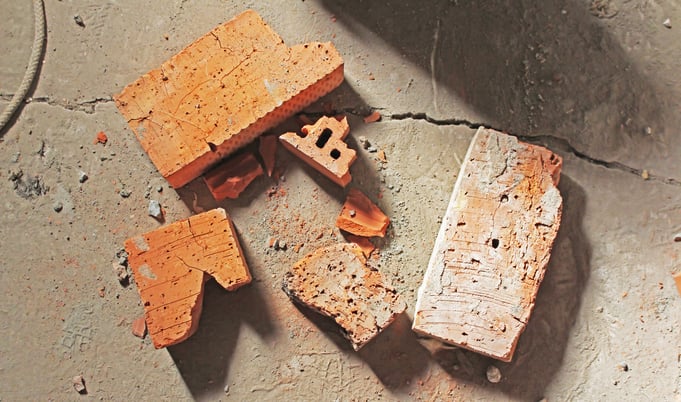
Drying is one of the most critical parts of making quality brick. There are a number of things that can be done to improve drying and reduce drying defects. In order to reduce cracking there needs to be an understanding of the drying process and understanding of the brick body that is being dried.
THE DRYING PROCESS
Drying of ceramics including brick occurs in stages. Understanding and maintaining control of the conditions during these stages is essential to preventing cracks.
STAGE 1
Once bricks are molded or extruded in the wet green state the drying process begins. The green ware immediately starts to give up moisture and begins to shrink. The temperature, relative humidity, and air flow conditions are all critical parameters that should be monitored and controlled during first stage drying.
- Bricks that are being set on kiln cars or bricks that are on kiln cars but have not been placed in the pre-dryer or dryer are exposed to ambient conditions. Ambient temperatures and relative humidity conditions may be too harsh for some brick bodies and can cause cracking almost immediately. In areas where this is the case or when brick bodies are sensitive, it may be necessary to control conditions around the setting machine and even outside the pre-dryer or dryer to prevent cracking.
- Green ware is normally loaded into a holding room or pre-dryer for a number of hours before being loaded into the dryer. The holding room or pre-dryer is often not well controlled with only the amount of green brick and a damper supplying warm air from the dryer controlling the conditions. This chamber would be better classified as a “conditioning room” as the conditions should be controlled and the brick should be prepared before being loaded into the dryer. The conditions in this area of first stage drying should consist of high relative humidity at 85% to 98% with temperatures of 80 degrees to 100 degrees Fahrenheit (27ºC to 37ºC). There should be some light air movement from the dryer end of the chamber toward the charging end or beginning of the chamber to wick off some moisture. This conditioning increases the temperature of the water in the brick which decreases its viscosity, making the water move more easily through the capillaries that are forming in the brick body. The longer a brick body can be conditioned under the right conditions the better the brick body will withstand the conditions in the dryer where more aggressive drying is performed. Brick that remain in the conditioning room under the proper conditions for eight hours or more will be more resilient in the dryer.
- The tunnel dryer continues the first stage of drying where weight loss and shrinkage are continued until the critical point where all of the shrinkage is complete. One again, temperature, relative humidity, and air flow should be well controlled. The temperature should increase gradually (10 – 15 degrees Fahrenheit per hour) from 100 degrees Fahrenheit (37ºC) to above boiling point or 212 degrees Fahrenheit (100ºC). Relative humidity should be maintained at as high a level as possible so as not to dry the surface of the brick prematurely and promote cracking. The relative humidity will decrease as the temperature increases. Once the brick has been in the dryer for 12 hours and the temperature is above 212 degrees Fahrenheit (100ºC), shrinkage should be complete and the temperature can be raised more rapidly in order to complete drying.
STAGE 2
Once brick have completed stage 1 drying and shrinkage is mostly complete the brick are ready to go through stage 2 drying.
- As brick continue through the tunnel dryer during second stage drying the temperature should be raised at a rate of 25 to 35 degrees Fahrenheit (0,5 to 1,5ºC) per hour until the end of the dryer and drying cycle. Most dryers in brick plants will reach 350 to 450 degrees Fahrenheit (177 to 232ºC) by the end of the cycle. The brick should contain less than 0.5% moisture when they exit the dryer and enter the tunnel kiln. If there is moisture in excess of 0.5% in the brick body going into the tunnel kiln the brick may crack or in extreme cases the shell may disintegrate.
THE BRICK BODY
The characteristics of the brick body being dried can contribute to successful drying to avoid cracking. The characteristics of the brick body include the type of clay minerals, the particle size distribution, the use of non-plastics, and the amount of moisture in the body.
- Clay minerals vary in their ability to hold and release water and in their adhesive qualities. There are many specific types of clays within the three groups listed below and most are found mixed with others.
- Montmorillonite clays hold a lot of moisture and contribute to drying issues. The clay swells when saturated with water and consequently has a high dry shrinkage.
- Illite clays hold a moderate amount of moisture but do not swell when saturated.
- Kaolinite clays hold a lower amount of moisture and do not swell or shrink much.
Testing in order to understand the minerals present in brick bodies can be performed at laboratories that run X-Ray Diffraction. In order to understand what specific elements such as iron are present, a lab that runs X-Ray Fluorescence must be used.
- The particle size distribution of a clay body can vary greatly depending on the clay minerals, grinding system, addition of other materials, and the ratios of the materials being mixed. Particles can be separated into sand, silt, and clay sizes. The ratio of these particle sizes in a clay body will have an effect on extrusion, drying firing, appearance, etc. Clay sized particles will tighten a body and slow the drying process while sand sized particles will open a clay body and allow for increased capillary flow. Increased clay particles can help with the adhesion of the brick body during drying while increased sand sized particles can result in decreased adhesion. Clay conditioners may be added to clay bodies to increase adhesion during drying while allowing the percentage of sand sized particles to be high enough for increased capillary flow. Particle size distribution can be tested through screening methods, sedimentation methods, and laser scattering. Some testing can be performed in house while laser scattering can be performed by outside laboratories.
- Drying is defined as the removal of moisture from the brick body. The moisture added to the clay mix in the pug mill is meant to make the clay more workable and easy to extrude. Normally reducing the additional water can result in problems extruding or a reduction in the plasticity of the clay. Clay conditioners can be used to help reduce the amount of water necessary to make the clay workable and plastic enough to be extruded and textured.





